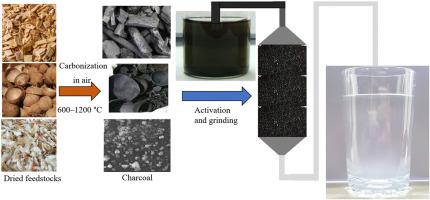Chemosphere ( IF 8.8 ) Pub Date : 2020-11-25 , DOI: 10.1016/j.chemosphere.2020.129087 Mohammad M. Hassan , Christopher M. Carr

|
Currently used textile dyes are not highly toxic or carcinogenic, but the intense and persistent color of the effluent is problematic. Of the remediation processes investigated, the adsorption process is attractive, and carbonaceous adsorbents (CAs) are ideal for that purpose because of their very high dye-binding capacity (DBC). In this review, the potential of biomass-based feedstocks to produce CAs and the application of the produced adsorbents for the removal of various types of dyes from effluent have been compiled and critically reviewed. The effect of preparation conditions on the surface area, porosity, pore volume, and chemical characteristics of the produced CAs has been outlined and discussed. The DBC of various CAs at the optimum conditions has been compiled, and dye-binding mechanisms, dye sorption isotherm models, the stability of adsorbents, and regeneration methods of CAs are discussed. The analysis of the compiled dye-adsorption data shows that the dye-adsorption capacity of some CAs derived from biomasses and their composites is considerably higher than the commercially available activated carbon (AC) adsorbents. For example, a commercial AC (Filtrasorb-400) showed 400 mg/g DBC for the C.I. Reactive Red 120 dye. Conversely, the CS-DB adsorbent showed excellent anionic and cationic DBC for C.I. Direct Red 28 and C.I. Basic Green 4 dyes, 20317 and 12502 mg/g respectively. The porous carbon/polyvinyl alcohol hydrogel and GO/zeolitic imidazolate framework composite adsorbents exhibited dye-adsorption capacity as high as 13381.6 and 3300 mg/g respectively. The pore volume and functional groups of dyes are the deciding factors in achieving high dye adsorption.
中文翻译:

生物质衍生的多孔碳质材料及其复合材料作为阳离子和阴离子染料的吸附剂:综述
当前使用的纺织染料不是剧毒或致癌的,但是废水的强烈和持久的颜色是有问题的。在研究的修复方法中,吸附过程很有吸引力,碳质吸附剂(CAs)由于其很高的染料结合能力(DBC)而非常适合该目的。在这篇综述中,对基于生物质的原料生产CA的潜力以及所生产的吸附剂从废水中去除各种类型染料的应用进行了汇编和严格的综述。概述并讨论了制备条件对生产的CA的表面积,孔隙率,孔体积和化学特性的影响。汇编了各种CA在最佳条件下的DBC,并建立了染料结合机理,染料吸附等温线模型,讨论了吸附剂的稳定性以及CAs的再生方法。对汇总的染料吸附数据的分析表明,某些衍生自生物质及其复合物的CA的染料吸附能力明显高于市售的活性炭(AC)吸附剂。例如,商用AC(Filtrasorb-400)对CI反应性红色120染料显示出400 mg / g DBC。相反,对于CI Direct Red 28和CI Basic Green 4染料,CS-DB吸附剂显示出优异的阴离子和阳离子DBC,分别为20317和12502 mg / g。多孔碳/聚乙烯醇水凝胶和GO /沸石咪唑酸酯骨架复合吸附剂分别显示出高达13381.6和3300 mg / g的染料吸附能力。



























 京公网安备 11010802027423号
京公网安备 11010802027423号